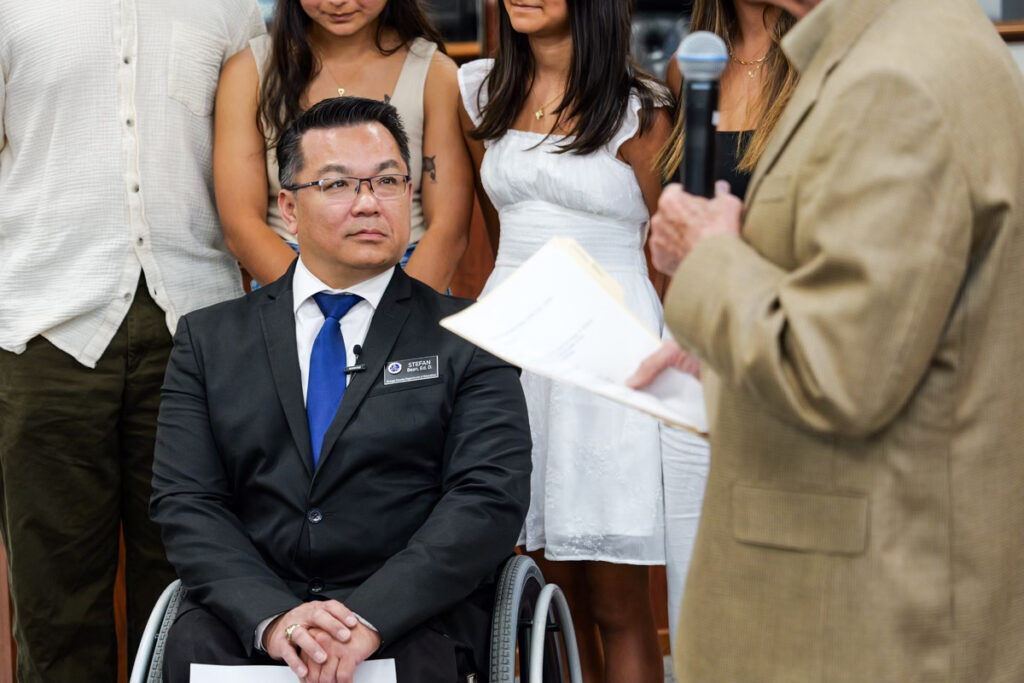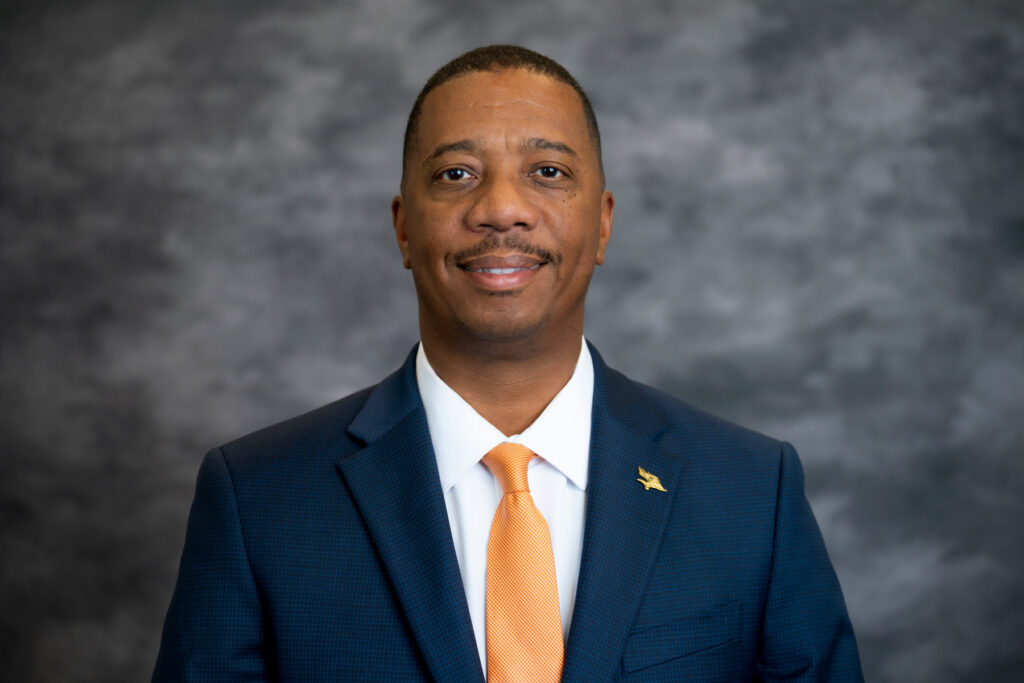
Stefan Bean is sworn in as Orange County’s 12th superintendent of schools on July 3, 2024.
Credit: Orange County Department of Education
Families of English learners and students with disabilities in Orange County can find inspiration and an ally in Stefan Bean. Supporters of school choice can find an advocate. In June, the five-member Orange County school board unanimously decided Bean has the perspective and skills they were looking for in a superintendent of the Orange County Department of Education.
Two years from now, voters will decide if the board made the right choice.
Bean, 53, was sworn in last month as superintendent to fill out the remaining two years of the term of former Supterintendent Al Mijares, who resigned because of a lengthy battle with cancer. First elected in 2012, Mijares, a past member of the EdSource board of directors, had battled the politically conservative board majority in court and at board meetings. So the board turned to Bean, who lost to Mijares by nearly 10 percentage points in 2022 but promised to consult with them over policies and control of the office’s $380 million budget.

Bean has lived a remarkable life and has an unusual resume for a county superintendent. Paralyzed from the waist down from polio as an infant, he was abandoned on the streets of Saigon before being taken in by an orphanage and then airlifted in 1975 to the United States as part of the Operation Babylift rescue during the chaotic end of the Vietnam War.
Judy and Gregory Bean took him and dozens of other foster children into their San Diego home and later adopted him. A scholarship recipient to USC, Bean became a public elementary school teacher in Fresno and Long Beach, and has spent the last 25 years as a charter school administrator — as the principal, then associate superintendent and superintendent for 11 Aspire Public Schools in Los Angeles.
Most recently, he served as the executive director of the Irvine International Academy, a Mandarin language immersion charter school.
Since his wife died of breast cancer in 2020, Bean has raised their four children, ranging from a daughter who has just graduated from USC, to the youngest daughter, who is in middle school.
EdSource interviewed Bean about his childhood, his perspective on education, and his priorities as county superintendent for two years before an election contest in 2026. His remarks have been edited for length and clarity.
Superintendent, talk about your upbringing and experiences in school.
Judy Bean really taught her family to have compassion for the most vulnerable in our community. She and Dad decided they would care for children who were abused, had issues or disabilities. They had two of their own children and adopted 10, several with disabilities. I had three Black sisters, two Latino brothers, and a Latino brother who passed away at 2 because he had suffered so much brain trauma.
I went to public school in San Diego, where I struggled in elementary school because English was my second language and because IDEA (the landmark federal Individuals with Disabilities Education Act) just came out in the ‘70s, and schools were still trying to figure out how to educate students with disabilities. I often found myself in small groups out of the classroom. It didn’t really help with my education to isolate me, and it shaped my drive to be inclusive in education.
I didn’t do very well until I met Donald Geisinger, my sixth-grade teacher. I remain friends with him 43 years later. He saw right through the challenges that I had and said, “Stefan, you’re just going to give oral presentations and skits on the things that you’ve learned — no need to write.” That whole year I just worked on my verbal skills. I spoke Vietnamese quite a bit, and by the end of that year, I began to speak pretty fluent English. From sixth grade on, I began to get straight A’s and (earned) a scholarship to USC.
His heart for students and his seeing my strengths was a springboard to do other things, such as speaking in front of 15,000 people in Washington, D.C., on behalf of the disabled.
How did your experiences shape your perspective on education?
Mr. Geisinger and my father saw people and students through an asset lens. Whether they’re on the autism spectrum or have a physical disability or emotional disability — sure, these are deficits, but we as educators must see the assets in those students, and then lift them up and empower students.
Leading from the heart
When you say lead from the heart again, how does that translate into action?
You lead with empathy. My mantra has been you involve those who are most affected by decisions. It’s not top-down directed. Obviously there are certain legal and personnel decisions that would have to be made without input. But a lot of decisions that impact educational programming can involve the community and can involve the stakeholders that are impacted by it.
I assume that would be a particular strength in dealing with parents of English learners and parents of students with disabilities.
Absolutely. I now represent many students who have traditionally been left behind. I certainly identify with those students, and I hope that they will look to me as a voice for them.
Your predecessor had a contentious relationship with the board. Since the board chose you, I assume you are more philosophically in tune with them.
I can’t speak on behalf of Dr. Mijares, but I certainly have the utmost respect for his leadership. If I can lead in a collaborative, transparent manner, then I think we can resolve any dispute between the board and the County Department of Education. In my appointment process, I shared my commitment to building collaboration, transparency, and trust and continuing to support our 28 school districts.
How will you do this?
It is common for school districts to have committees in which two (out of five members), sometimes three if you have a larger board, can serve on these committees to really give input (without violating the Brown Act governing open meetings) and receive feedback.
You have been quoted as saying you want to “further expand” the board’s work supporting charters and open up more parental options for education, including charter schools and home schools. Is this a matter of using the bully pulpit? What can and will you do?
As people have been learning about me and meeting me and hearing my vision, they would say that I’m far from using this as a bullying pulpit. It’s the complete opposite, actually. My vision is to lead from the heart in which we serve our principals and serve our schools in this work. But to answer your question, this board certainly believes in alternative education models and therefore charter schools. I believe that most of the superintendents that I’ve met believe that our students have different needs. Therefore, in the name of equity, we must provide what our students need.
How does that work with homeschooling, though?
Many home schools now are charters, and charters are heavily regulated in all aspects. We support charter schools that do the independent study model, which is a lot like home school. We don’t support the private home school models. We do have within the department an independent study model in which students learn from home.
County offices can approve countywide charters but don’t charter proposals go through their individual districts for approval?
A charter school’s initial application goes to a local school district, and then if it’s denied there, they can bring it to their county as a county charter school. That’s one pathway. And then usually, those county charter schools can then later submit to be a countywide charter school. We have over 30 charter schools.
But don’t county boards have restrictions on when they can overturn a local decision?
If a district has denied a charter, they of course have to explain the reasons why. Then that charter can take it to the county board of education and say, “OK, this district denied us for A, B and C. And here’s how we have responded to A, B, and C. So now we would like you to authorize the charter.” There are few restrictions. Our county can certainly do that.
The importance of social-emotional learning
What is your view of social-emotional learning (SEL)?
Social-emotional learning is very important in schools when we do it as a team in a collaborative way. That includes our parents. Social emotional learning is simply helping our students navigate through the challenges of their lives. Helping them to become resilient. That’s exactly what I grew up with. I’ve had many adversities that our students experience. To overcome those, adults, including my parents, teachers, counselors, speech pathologists, special education providers, all of these people helped me to overcome my challenges to become resilient and competent. And that’s what SEL should be doing.
I have cautioned educators (not) to use it as a political tool to push forward something that may not be protecting our students. For instance, I believe 100% that parental involvement is absolutely critical in our education system. And so, if SEL is being used to exclude some of our parents, then we’ve missed the mark. That’s where I’m critical.
What are your priorities for the next two years?
The first priority is just to continue understanding the assets and the values of the department of education throughout Orange County.
My second vision is to remain at the forefront of 21st century competencies and skills and lead the way for our students through our OC Pathways partnerships with districts and ACCESS (Alternative, Community, and Correctional Education Schools and Services) what we call our 29th school district. We serve thousands of students across our county in an alternative education setting and model.
Assuming you do want to run in two years, what will you point to and say, “I’ve made this change, and it’s visible and it affects the way students succeed or not.”
It will be in the areas of where we will lead the nation, in college and career readiness. I wholeheartedly believe in that vision. One of my pushes will be to use some of our reserves to provide grants to our school districts in order to create and promote innovative programming. Three groups I spoke with recently were focused on artificial intelligence, different technical skills and student leadership. Our districts will come up with great ideas, and we will honor them with resources to implement them.


